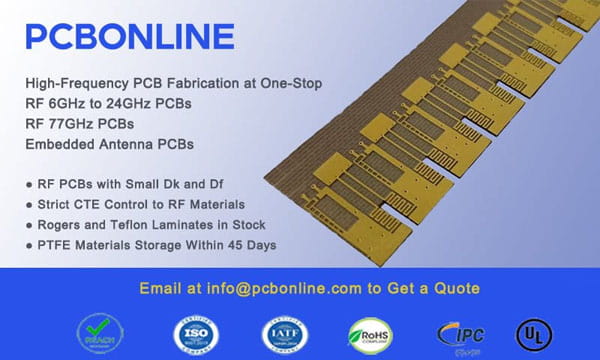What is the definition of high-speed PCB? In many articles, we often see expressions like high-speed/high-frequency PCBs, high-speed PCB manufacturers, high-frequency PCB designs, and so on. However, we rarely see an article to distinguish between high-speed PCBs and high-frequency PCBs. Are high-speed PCBs and high-frequency PCBs the same? In this article, we will illustrate everything clearly.
Part 1. What is a High-Speed PCB
![]()
There is a point about the definition of high-speed PCBs: a high-speed PCB is a circuit board having a digital circuit speed at or above 45 to 50MHZ, and digital circuit signals account for more than one-third of the entire system. But is this definition of high-speed PCBs correct? If you take it for granted, and when you are doing a PCB project whose maximum signal speed reaches 49.9MHz, you feel relieved because this is not a high-speed PCB and keep moving on. Finally, the PCB fails, the delivery has to be delayed, and you miss the expected bonus.
High-speed PCBs do not have an authoritative definition. Back in the 1960s, when digital electronics began developing, the signal speed was low, and PCB design could be done without much effort. Later, the digital circuit signal speed elevates, and engineers find that traditional PCB designing doesn’t work for these high-speed circuits, so they optimize the circuit design and use specific PCB base materials. The PCBs developed for these high-speed circuits are called high-speed PCBs. But no specific signal speed value is defined for speed-speed values, and no necessity to do it. How to define high-speed PCBs depends on practices: whether the signal speed is high enough to affect the circuit impedance or other circuits/components, whether there appears signal radiation in the circuit board, whether there appears skin effect or ionization loss, etc.
Part 2: Are High-Speed PCBs and High-Frequency PCBs the Same Thing?
Though high speed and high frequency have different meanings, high-speed PCBs and high-frequency PCBs are the same printed circuit boards. The carrier of modulated signals is the sine wave. A high-speed circuit means the voltage rises or drops in a short period, and a high-frequency circuit means the circuit cycle is short (frequency is the reciprocal of the period).
![]()
When the signal frequency rises, the cycle shortens. In the cycle, to ensure enough time for the signal to maintain stability, the time for the signal to rise and drop has to be short. So this leads to high speed. In other words, high-frequency PCBs are also high-speed PCBs.
There is no exact distinction between high-speed PCBs and high-frequency PCBs. Even their base materials are the same. So when someone asks the difference between high-speed PCBs and high-frequency PCBs, tell them to ignore the name of the circuit board and focus on how to keep the circuit signal integrity.
Part 3. What Should We Care about - High-Speed PCB Signal Integrity
High-speed/high-frequency PCBs are difficult to design because the signals can easily radiate/couple and affect the signal quality. Here are some points to keep high-speed PCB signal integrity:
- 1. PCB wires should be short and avoid loops. (don't make them become antennas).
- 2. Have a ground layer and a power layer to shield signal radiation between layers.
- 3. Reduce distributed inductance and electromagnetic compatibility of when auto wiring for the key signals.
- 4. Place the wave filter and decoupling components near the interface.
- 5. When the circuit board has high, medium, and low-speed signals, keep the high and medium-speed signals away from the interface.
For more design tips for high-speed PCBs, you can refer to the article How to Design High-Frequency PCBs.
Part 4. Successful High-Speed PCB Projects at One-Stop
A high-speed PCB project aims to deliver the products in time, if possible, successfully at once. So the high-speed PCB was better manufactured by an experienced manufacturer who provides design for manufacturing and excellence (DFM and DFX). PCBONLINE is a one-stop high-speed PCB manufacturer with 22 years of experience and provides free one-on-one engineering support for high-speed/high-frequency PCB projects.

You will find PCBONLINE as a reliable high-speed PCB manufacturer for these reasons:
- Check high-speed PCB designs before giving a quote, and provide suggestions for free if there are problems.
- Provide one-stop manufacturing solutions, including free DFM and DFX to high-speed PCB projects.
- Grasp the core technologies for high-speed PCB manufacturing such as impedance control, embedded antenna DFM, expansion/contraction control, etc.
- Have ready-to-use high-speed PCB base materials in stock, and the storage period is within 45 days (at manufacturers who have no storage, it usually takes 2 to 3 months to purchase base materials).
- Manufacture 4 to 8 layers of high-speed/high-frequency PCBs such as RF 6 to 24GHz PCBs, RF 77GHz PCBs, and embedded antenna PCBs.
If you want to work with a reliable high-speed PCB manufacturer, register online, and you will get $100 coupons for online purchases. Or you can contact PCBONLINE by email or online.
Conclusion
High-speed PCBs and high-frequency PCBs are the same PCBs. How to decide if a circuit board is a high-speed PCB depends on whether the signals' frequency components require special attention. If you want to have your high-speed PCB project done successfully at once in time, work with the reliable high-speed/high-frequency PCB manufacturer PCBONLINE.
- What is High-Frequency PCB? Its Structure and Types
- What is Rogers PCB and How Much Do Those PCBs Cost
- PCB Antenna: What is It and How to Calculate Parameters
- Best Quality Ceramic PCB Manufacturing and Assembly for High Power LED and Device
- Aluminum PCB: Amazing Heat Dissipation, Low Prices, Industry 4.0 Manufacturing
Related Content:




